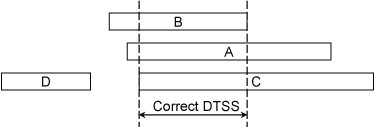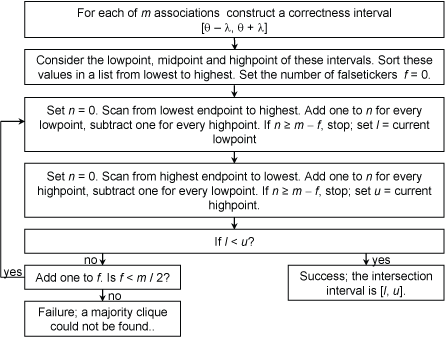
Figure 1. Intersection Interval
Last update: 10-Mar-2014 05:22 UTC
The clock select algorithm determines from a set of sources , which are correct (truechimers) and which are not (falsetickers) according to a set of formal correctness assertions. The principles are based on the observation that the maximum error in determining the offset of a candidate cannot exceed one-half the roundtrip delay to the primary reference clock at the time of measurement. This must be increased by the maximum error that can accumulate since then. The selection metric, called the root distance,, is one-half the roundtrip root delay plus the root dispersion plus minor error contributions not considered here.
First, a number of sanity checks is performed to sift the selectable candidate from among the source population. The sanity checks are sumarized as follows:.
While the NTP algorithm is based on DTSS, it remains to establish which point in the correctness interval represents the best estimate of the offset for each candidate. The best point is at the midpoint θ0 of the correctness interval; however, the midpoint might not be within the intersection interval. A candidate with a correctness interval that contains points in the intersection interval is a truechimer and the best offset estimate is the midpoint of its correctness interval. A candidate with a correctness interval that contains no points in the intersection interval is a falseticker.

Figure 1. Intersection Interval
Figure 1 shows correctness intervals for each of four candidates A, B, C and D. We need to find the maximum number of candidates that contain points in common. The result is the interval labeled DTSS. In the figure there are three truechimers A, B and C, and one falseticker D. In DTSS any point in the intersection interval can represent the true time; however, as shown below, this may throw away valuable statistical information. In any case, the clock is considered correct if the number of truechimers found in this way are greater than half the total number of candidates.
The question remains, which is the best point to represent the true time of each correctness interval? Fortunately, we already have the maximum likelihood estimate at the midpoint of each correctness interval. But, while the midpoint of candidate C is outside the intersection interval, its correctness interval contains points in common with the intersection interval, so the candidate is a truechimer and the midpoint is chosen to represent its time.
The DTSS correctness assertions do not consider how best to represent the truechimer time. To support the midpoint choice, consider the selection algorithm as a method to reject correctness intervals that cannot contribute to the final outcome; that is, they are falsetickers. The remaining correctness intervals can contribute to the final outcome; that is, they are truechimers. Samples in the intersection interval are usually of very low probability and thus poor estimates for truechimer time. On the other hand, the midpoint sample produced by the clock filter algorithm is the maximum likelihood estimate and thus best represents the truechimer time.

Figure 2. Clock Select Algorithm
The algorithm operates as shown in Figure 2. Let m be the number of candidates and f the number of falsetickers, initially zero. Move a pointer from the leftmost endpoint towards the rightmost endpoint in Figure 1 and count the number of candidates, stopping when that number reaches m − f; this is the left endpoint of the intersection interval. Then, do the same, but moving from the rightmost endpoint towards the leftmost endpoint; this is the right endpoint of the intersection interval. If the left endpoint is less than the right endpoint, the intersection interval has been found. Otherwise, increase f by 1. If f is less than n / 2, try again; otherwise, the algorithm fails and no truechimers could be found.
The clock select algorithm again scans the correctness intervals. If the right endpoint of the correctness interval for a candidate is greater than the left endpoint of the intersection interval, or if the left endpoint of the correctness interval is less than the right endpoint of the intersection interval, the candidate is a truechimer; otherwise, it is a falseticker.
In practice, with fast LANs and modern computers, the correctness interval can be quite small, especially when the candidates are multiple reference clocks. In such cases the intersection interval might be empty, due to insignificant differences in the reference clock offsets. To avoid this, the size of the correctness interval is padded to the value of mindist, with default 1 ms. This value can be changed using the mindist option of the tos command.